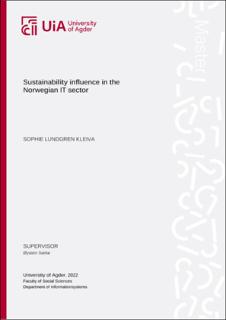| dc.description.abstract | Adopting sustainability practices into business model has become quite applicable for
organizations to do. There are adding up more demands relating to working more sustainable to
help save and improve the planet and society. One known opportunity to solve the sustainability
problems is with technology and digitalization. For those reasons the IT sector is in an interesting
position of how they choose to embrace the trend of sustainability practices.
Through a qualitative method, with 8 semi-structured interviews, this study investigates how the
trend of sustainability are influencing the Norwegian IT sector. The study interviewed executives
from big IT organizations that all belong to the GoForIT network, and how have a known focus
on sustainability. Along with the data from the interviews were also documents used as
supplemental data.
The results are presented in framework for sustainability practices by Jacobsen et al. (2020) who
have categorized four levels of sustainability practices: Inspire and inform, productize, cocreation, and system building. These categories ranges over different scopes within the
organizational structure. The first level of inspire and inform are for internal actions and here
the main focus were the training and education of their employees to learn about sustainability
and gain an internal motivation to work with the subject. The second level of productize were
between customer and organization, and external perspective regarding helping customer with
digitalization and sustainability practices. The focus around co-creation regards the value chain
that the organization belong to. They feel pressure from customers, stakeholder, and partners,
as well as a market pressure to keep up with the trend. The final category is system building and
focus on engaging and changing the industry level. They explained how the conversation of
sustainable development have become more relevant in the last years, as more people are
familiar with the concepts and its importance. They seek out these perspectives from other actors
in the industry such as partner, competitors, and academia to get insight into how others work
with sustainability.
In conclusion the IT industry is changing at a fast paste to keep up with the trend of sustainability.
The industry varies in maturity both from the organizations side and the customer side. As digital
transformation and technology are seen as solutions of sustainability challenges, the IT industry
have somewhat of an expectation around them to able to support with that. The topic of
sustainability is also a driver for collaboration between different actors to tackle sustainability
problems and share experiences with each other across the industry | |
